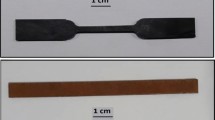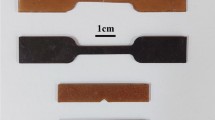Abstract
This study aims to investigate the tensile strength of the polypropylene-based bio-composites reinforced with natural kenaf fibers, basalt fiber, and nanographenes. The response surface methodology was used to investigate the behavior of the bio-composites based on the weight percentage of basalt and kenaf fibers and nanographenes. The behavior of the samples was analyzed using the tensile test, and the results were interpreted using field emission scanning electron microscope images. The fracture surface of the samples indicated the fibers’ breakage and their separation as well as the pullout of the fibers from the substrate as the main mechanisms in improving the behavior of the bio-composite under study. Then, the multi-objective optimization was performed by increasing the tensile strength and elastic modulus and reducing the weight of the samples, and a Pareto diagram was drawn according to the design objectives. The results showed that the bio-composite sample in the optimal status with the maximum tensile strength of 30.9481 MPa and the lowest weight includes 15% kenaf fibers and 0.862% graphene nanoparticles. Moreover, the optimal sample of the bio-composite with the highest elastic modulus of 3.5126 GPa and the minimum weight of 1.626 g consists of 15% of kenaf fiber and 1.5% of graphene nanoparticles. Twenty-seven percent reduction in composite weight by optimizing the amount of reinforcements causes the weight of the final structure to be significantly reduced in the use of these composite plates in high volumes.
















Similar content being viewed by others
Availability of data and materials
The data that support the finding of this study are available based on the request from the corresponding author.
References
AL-Oqla FM, Sapuan SM, Ishak MR, Nuraini AA (2015) A model for evaluating and determining the most appropriate polymer matrix type for natural fiber composites. Int J Polym Anal Charact 20(3):191–205. https://doi.org/10.1080/1023666X.2015.990184
AL-Oqla FM, Sapuan SM, Jawaid M (2016) Integrated mechanical-economic–environmental quality of performance for natural fibers for polymeric-based composite materials. J Nat Fibers 13(6):651–659. https://doi.org/10.1080/15440478.2015.1102789
Al-Oqla FM, Sapuan SM, Ishak MR, Nuraini AA (2016) A decision-making model for selecting the most appropriate natural fiber: polypropylene-based composites for automotive applications. J Compos Mater 50(4):543–556. https://doi.org/10.1177/0021998315577233
Al-Oqla FM, Salit MS, Ishak MR, Aziz NA (2014) Combined multi-criteria evaluation stage technique as an agro waste evaluation indicator for polymeric composites: date palm fibers as a case study. BioResources 9(3):4608–4621. https://doi.org/10.15376/biores.9.3.4608-4621
Al-Oqla FM, Salit MS (2017) Materials selection for natural fiber composites. Elsevier
AL-Oqla FM, Sapuan SM, Ishak MR, Nuraini AA (2015) Predicting the potential of agro waste fibers for sustainable automotive industry using a decision making model. Comput Electron Agric 113:116–127. https://doi.org/10.1016/j.compag.2015.01.011
Khanjanzadeh H, Tabarsa T, Shakeri A (2012) Morphology, dimensional stability and mechanical properties of polypropylene-wood flour composites with and without nanoclay. J Reinf Plast Compos 31(5):341–350. https://doi.org/10.1177/0731684412438793
Zahedi M, Khanjanzadeh H, Pirayesh H, Saadatnia MA (2015) Utilization of natural montmorillonite modified with dimethyl, dehydrogenated tallow quaternary ammonium salt as reinforcement in almond shell flour-polypropylene bio-nanocomposites. Compos Part B Eng 71:143–151. https://doi.org/10.1016/j.compositesb.2014.11.009
Zahedi M, Pirayesh H, Khanjanzadeh H, Tabar MM (2013) Organo-modified montmorillonite reinforced walnut shell/polypropylene composites. Mater Des 51:803–809. https://doi.org/10.1016/j.matdes.2013.05.007
Khanjanzadeh H, Pirayesh H, Salari A (2013) Long term hygroscopic characteristics of polypropylene based hybrid composites with and without organo-modified clay. Eur J Wood Wood Prod 71(2):211–218. https://doi.org/10.1007/s00107-012-0661-4
Karnani R, Krishnan M, Narayan R (1997) Biofiber-reinforced polypropylene composites. Polym Eng Sci 37(2):476–483. https://doi.org/10.1002/pen.11691
Sanjay MR, Madhu P, Jawaid M, Senthamaraikannan P, Senthil S, Pradeep S (2018) Characterization and properties of natural fiber polymer composites: a comprehensive review. J Clean Prod 172:566–581. https://doi.org/10.1016/j.jclepro.2017.10.101
Ahmad F, Choi HS, Park MK (2015) A review: natural fiber composites selection in view of mechanical, light weight, and economic properties. Macromol Mater Eng 300(1):10–24. https://doi.org/10.1002/mame.201400089
Pickering KL, Efendy MGA, Le TM (2016) A review of recent developments in natural fibre composites and their mechanical performance. Compos Part A Appl Sci Manuf 83:98–112. https://doi.org/10.1016/j.compositesa.2015.08.038
AL-Oqla FM, Hayajneh MT (2022) Stress failure interface of cellulosic composite beam for more reliable industrial design. Int J Interact Des Manuf 16(4):1727–1738. https://doi.org/10.1007/s12008-022-00884-3
Yusoff RB, Takagi H, Nakagaito AN (2016) Tensile and flexural properties of polylactic acid-based hybrid green composites reinforced by kenaf, bamboo and coir fibers. Ind Crops Prod 94:562–573. https://doi.org/10.1016/j.indcrop.2016.09.017
Teng JG, Chen JF, Smith ST, Lam L (2003) Behaviour and strength of FRP-strengthened RC structures: a state-of-the-art review. ICE Proc Struct Build 156(3):334–335. https://doi.org/10.1680/stbu.156.3.334.37862
Yaghoobi H, Fereidoon A (2018) An experimental investigation and optimization on the impact strength of kenaf fiber biocomposite: application of response surface methodology. Polym Bull 75(8):3283–3309. https://doi.org/10.1007/s00289-017-2212-y
Yaghoobi H, Fereidoon A (2019) Thermal analysis, statistical predicting, and optimization of the flexural properties of natural fiber biocomposites using Box-Behnken experimental design. J Nat Fibers 16(7):987–1005. https://doi.org/10.1080/15440478.2018.1447416
AL-Oqla FM (2022) Manufacturing and delamination factor optimization of cellulosic paper/epoxy composites towards proper design for sustainability. Int J Interact Des Manuf. https://doi.org/10.1007/s12008-022-00980-4
AL-Oqla FM, Hayajneh MT, Al-Shrida MM (2022) Mechanical performance, thermal stability and morphological analysis of date palm fiber reinforced polypropylene composites toward functional bio-products. Cellulose 29(6):3293–3309. https://doi.org/10.1007/s10570-022-04498-6
Singh JIP, Singh S, Dhawan V (2020) Influence of fiber volume fraction and curing temperature on mechanical properties of jute/PLA green composites. Polym Polym Compos 28(4):273–284. https://doi.org/10.1177/0967391119872875
Qi G, Zhang B, Yu Y (2016) Research on carbon fiber/epoxy interfacial bonding characterization of transverse fiber bundle composites fabricated by different preparation processes: effect of fiber volume fraction. Polym Test 52:150–156. https://doi.org/10.1016/j.polymertesting.2016.03.022
Khanjanzadeh H, Tabarsa T, Shakeri A, Omidvar A (2011) Effect of organoclay platelets on the mechanical properties of wood–plastic composites formulated with virgin and recycled polypropylene. Wood Mater Sci Eng 6(4):207–212. https://doi.org/10.1080/17480272.2011.606915
Wang Z, Luo Q, Li Q, Sun G (2022) Design optimization of bioinspired helicoidal CFRPP/GFRPP hybrid composites for multiple low-velocity impact loads. Int J Mech Sci 219:107064. https://doi.org/10.1016/j.ijmecsci.2022.107064
Hassan F, Zulkifli R, Ghazali MJ, Azhari CH (2017) Kenaf fiber composite in automotive industry: an overview. Int J Adv Sci Eng Inf Technol 7(1):315. https://doi.org/10.18517/ijaseit.7.1.1180
Colombo C, Vergani L, Burman M (2012) Static and fatigue characterisation of new basalt fibre reinforced composites. Compos Struct 94(3):1165–1174. https://doi.org/10.1016/j.compstruct.2011.10.007
Valentino P, Romano M, Ehrlich I, Furgiuele F, Gebbeken N (2013) “Mechanical characterization of basalt fibre reinforced plastic with different fabric reinforcements: tensile tests and FE-calculations with representative volume elements (RVEs). Frat ed Integrità Strutt. 8(28):1–11
Banibayat P, Patnaik A (2014) Variability of mechanical properties of basalt fiber reinforced polymer bars manufactured by wet-layup method. Mater Des 56:898–906. https://doi.org/10.1016/j.matdes.2013.11.081
Jacob GC, Starbuck JM, Fellers JF, Simunovic S, Boeman RG (2004) Strain rate effects on the mechanical properties of polymer composite materials. J Appl Polym Sci 94(1):296–301. https://doi.org/10.1002/app.20901
Xiao X (2008) Dynamic tensile testing of plastic materials. Polym Test. https://doi.org/10.1016/j.polymertesting.2007.09.010
Ou Y, Zhu D (2015) Tensile behavior of glass fiber reinforced composite at different strain rates and temperatures. Constr Build Mater. https://doi.org/10.1016/j.conbuildmat.2015.08.044
Al-Zubaidy H, Zhao XL, Al-Mahaidi R (2013) Mechanical characterisation of the dynamic tensile properties of CFRP sheet and adhesive at medium strain rates. Compos Struct. https://doi.org/10.1016/j.compstruct.2012.09.032
Naresh K, Shankar K, Rao BS, Velmurugan R (2016) Effect of high strain rate on glass/carbon/hybrid fiber reinforced epoxy laminated composites. Compos Part B Eng. https://doi.org/10.1016/j.compositesb.2016.06.007
Barré S, Chotard T, Benzeggagh ML (1996) Comparative study of strain rate effects on mechanical properties of glass fibre-reinforced thermoset matrix composites. Compos A Appl Sci Manuf. https://doi.org/10.1016/1359-835X(96)00075-9
Shishevan FA, Akbulut H, Mohtadi-Bonab MA (2017) Low velocity impact behavior of basalt fiber-reinforced polymer composites. J Mater Eng Perform 26(6):2890–2900. https://doi.org/10.1007/s11665-017-2728-1
Ralegaonkar R, Gavali H, Aswath P, Abolmaali S (2018) Application of chopped basalt fibers in reinforced mortar: a review. Constr Build Mater 164:589–602. https://doi.org/10.1016/j.conbuildmat.2017.12.245
Eslami-Farsani R, Reza Khalili SM, Hedayatnasab Z, Soleimani N (2014) “Influence of thermal conditions on the tensile properties of basalt fiber reinforced polypropylene–clay nanocomposites. Mater Des 53:540–549. https://doi.org/10.1016/j.matdes.2013.07.012
Chen W et al (2017) Quasi-static and dynamic tensile properties of basalt fibre reinforced polymer. Compos Part B Eng 125:123–133. https://doi.org/10.1016/j.compositesb.2017.05.069
Mittal V (ed) (2012) Polymer-graphene nanocomposites. Royal Society of Chemistry, Cambridge
Shokrieh MM, Joneidi VA (2014) Manufacturing and experimental characterization of graphene/polypropylene nanocomposites. Modares Mech Eng 13(11):55–63
Song P, Cao Z, Cai Y, Zhao L, Fang Z, Fu S (2011) Fabrication of exfoliated graphene-based polypropylene nanocomposites with enhanced mechanical and thermal properties. Polymer 52(18):4001–4010
Yuan B, Bao C, Song L, Hong N, Liew KM, Hu Y (2014) Preparation of functionalized graphene oxide/polypropylene nanocomposite with significantly improved thermal stability and studies on the crystallization behavior and mechanical properties. Chem Eng J 237:411–420. https://doi.org/10.1016/j.cej.2013.10.030
basaltex, “Basalt fiber composite fabric 9–17,” [Online]. Available: https://www.nauticexpo.com/prod/cbg-composites-gmbh/product-198399-564726.html
Tharazi I et al (2017) Optimization of hot press parameters on tensile strength for unidirectional long kenaf fiber reinforced polylactic-acid composite. Procedia Eng 184:478–485. https://doi.org/10.1016/j.proeng.2017.04.150
Islam MR, Beg MDH, Gupta A, Mina MF (2013) Optimal performances of ultrasound treated kenaf fiber reinforced recycled polypropylene composites as demonstrated by response surface method. J Appl Polym Sci 128(5):2847–2856. https://doi.org/10.1002/app.38454
Czigány T (2005) Basalt fiber reinforced hybrid polymer composites. Mater Sci Forum 473–474:59–66. https://doi.org/10.4028/www.scientific.net/MSF.473-474.59
Funding
The authors received no financial support for the research, authorship, and publication of this article.
Author information
Authors and Affiliations
Corresponding author
Ethics declarations
Conflict of interest
For our article, entitled "Statistical predicting and optimization of the tensile properties of natural fiber bio-composites," which has been submitted to your journals for review, there is no conflict of interest.
Consent for publication
The authors give their full permission for the publication and reproduction of the manuscript.
Additional information
Publisher's Note
Springer Nature remains neutral with regard to jurisdictional claims in published maps and institutional affiliations.
Rights and permissions
Springer Nature or its licensor (e.g. a society or other partner) holds exclusive rights to this article under a publishing agreement with the author(s) or other rightsholder(s); author self-archiving of the accepted manuscript version of this article is solely governed by the terms of such publishing agreement and applicable law.
About this article
Cite this article
Taghipoor, H., Mirzaei, J. Statistical predicting and optimization of the tensile properties of natural fiber bio-composites. Polym. Bull. 80, 13217–13241 (2023). https://doi.org/10.1007/s00289-023-04713-9
Received:
Revised:
Accepted:
Published:
Issue Date:
DOI: https://doi.org/10.1007/s00289-023-04713-9




